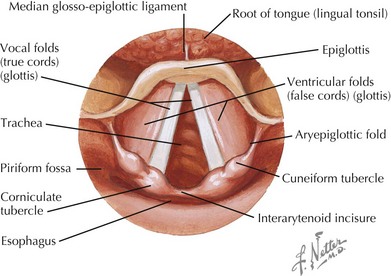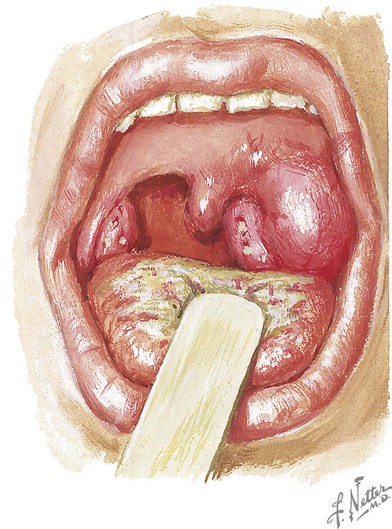36 Stridor
Etiology and Pathogenesis
Stridor can be caused by any upper airway obstruction. When thinking about the causes of stridor, it is helpful to first understand the anatomy of the larynx (Figure 36-1) and then to separate the causes of stridor into chronic and acute processes.
Acute Stridor
The causes of acute stridor are primarily infectious in cause with two notable exceptions, foreign body aspiration and allergic reaction. The most common cause of acute stridor is laryngotracheobronchitis, or croup (Figure 36-2). Croup is classically caused by parainfluenza virus but can also be caused by respiratory syncytial virus, influenza, adenovirus, and Mycoplasma pneumoniae. Bacterial tracheitis, usually caused by Staphylococcus aureus, is an uncommon but life-threatening condition that occurs most frequently as a bacterial superinfection in patients who have viral croup.
Clinical Presentation
Acute Stridor
Retropharyngeal abscess usually occurs in children younger than 6 years old before the retropharyngeal lymph nodes atrophy. Patients often have a viral prodome followed by the abrupt onset of high fever, limited neck movement (especially resistance to extension), and occasionally stridor. Unilateral neck swelling may occur as the infection tracks from the retropharyngeal space, and a bulge of the posterior oropharynx may sometimes be present on physical examination. Peritonsillar abscess occurs in preadolescents and adolescents and can present with sore throat, trismus, dysphagia, a “hot potato” or muffled voice, and tender unilateral neck swelling. Asymmetric tonsils, deviation of the uvula, and a fluctuant area are present on physical examination (Figure 36-3). Stridor may be heard if tracheal compression is present. Epiglottitis classically presents with the abrupt onset of high fever, stridor, drooling, “tripod” positioning, and toxicity.
< div class='tao-gold-member'>
Stay updated, free articles. Join our Telegram channel

Full access? Get Clinical Tree





